苏州大学:物理科学与技术学院物理学专业《热力学与统计物理》课程教学大纲(英文)
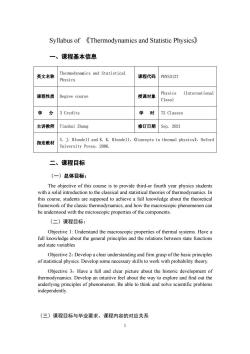
Syllabus of Thermodynamics and Statistic Physics) 一、课程基本信息 英文名称 Thermodynamics and Statistical 课程代码 PHYS3127 Physics 课程性质 Degree course 授课对象 Physics (International Class) 学分 3 Credits 学时 72 Classes 主讲教师Tianhui Zhang 修订日期 Sep.2021 指定教材 S.J.Blundell and K.K.Blundell,(Concepts in thermal physics),Oxfor University Press,2006. 二、课程目标 (一)总体目标: The objective of this course is to provide third-or fourth year physics students with a solid introduction to the classical and statistical theories of thermodynamics.In this course.students are supposed to achieve a full knowledge about the theoretical frame ork of the classic th nodynamies,and how the phenomenon can (二)课程目标: Objective 1:Understand the macroscopic properties of thermal systems.Have a full knowledge about the general principles and the relations between state functions and state variables Objective 2:Develop a clear understanding and firm grasp of the basic principles of statistical physics.Develop some necessary skills to work with probability theory. Objective 3:Have a full and clear picture about the historic development of thermodynamics.Develop an intuitive feel out the vay to explore an d find out the underlying principles of phenomenon.Be able to think and solve scientific problems independently. (三)课程目标与毕业要求、课程内容的对应关系 1
1 Syllabus of 《Thermodynamics and Statistic Physics》 一、课程基本信息 英文名称 Thermodynamics and Statistical Physics 课程代码 PHYS3127 课程性质 Degree course 授课对象 Physics (International Class) 学 分 3 Credits 学 时 72 Classes 主讲教师 Tianhui Zhang 修订日期 Sep. 2021 指定教材 S. J. Blundell and K. K. Blundell,《Concepts in thermal physics》,Oxford University Press,2006. 二、课程目标 (一)总体目标: The objective of this course is to provide third-or fourth year physics students with a solid introduction to the classical and statistical theories of thermodynamics. In this course, students are supposed to achieve a full knowledge about the theoretical framework of the classic thermodynamics, and how the macroscopic phenomenon can be understood with the microscopic properties of the components. (二)课程目标: Objective 1: Understand the macroscopic properties of thermal systems. Have a full knowledge about the general principles and the relations between state functions and state variables Objective 2:Develop a clear understanding and firm grasp of the basic principles of statistical physics. Develop some necessary skills to work with probability theory. Objective 3:Have a full and clear picture about the historic development of thermodynamics. Develop an intuitive feel about the way to explore and find out the underlying principles of phenomenon. Be able to think and solve scientific problems independently. (三)课程目标与毕业要求、课程内容的对应关系
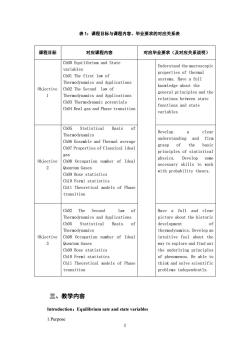
表1:课程目标与课程内容、毕业要求的对应关系表 课程目标 对应课程内容 对应毕业要求(及对应关系说明) Ch00 Equilibrium and State Understand the macroscopic variables properties of thermal Chol The first law of systems.Have a full Thermodynamics and Applications Objective Ch02 The Second law knowledge about the general principles and the Thermodynamics and Applications Ch03 Thermodynamic potentials relations between state functions and state Ch04 Real gas and Phase transition variables Ch05 Statistical Basis Develop clear Thermodynamics Ch06 Ensemble and Thermal average understanding and firm grasp of the basic Cho7 Properties of classical ideal principles of statistical Objective physics. 2 Quantum Gases necessary skills to work with probability theory. Ch09 Bose statistics Ch10 Fermi statistics Ch11 Theoretical models of Phas transition Ch02 The Second law of Have a full and clear Thermodynamics and applications picture about the historic Cho5 Basis of developmen o odynamics thermodynamics.Develop ar Objective Ch08 Occupation number of Ideal intuitive feel about the 3 I Quantum Gases way to explore and find out Ch09 Bose statistics the underlving principles Ch10 Fermi statistics of phenomenon.Be able to Chl1 Theoretical models of Phase think and solve scientifi transition problems independently. 三、教学内容 Introduction:Equilibrium sate and state variables 1.Purpose 2
2 表 1:课程目标与课程内容、毕业要求的对应关系表 三、教学内容 Introduction:Equilibrium sate and state variables 1.Purpose 课程目标 对应课程内容 对应毕业要求(及对应关系说明) Objective 1 Ch00 Equilibrium and State variables Ch01 The first law of Thermodynamics and Applications Ch02 The Second law of Thermodynamics and Applications Ch03 Thermodynamic potentials Ch04 Real gas and Phase transition Understand the macroscopic properties of thermal systems. Have a full knowledge about the general principles and the relations between state functions and state variables Objective 2 Ch05 Statistical Basis of Thermodynamics Ch06 Ensemble and Thermal average Ch07 Properties of Classical ideal gas Ch08 Occupation number of Ideal Quantum Gases Ch09 Bose statistics Ch10 Fermi statistics Ch11 Theoretical models of Phase transition Develop a clear understanding and firm grasp of the basic principles of statistical physics. Develop some necessary skills to work with probability theory. Objective 3 Ch02 The Second law of Thermodynamics and Applications Ch05 Statistical Basis of Thermodynamics Ch08 Occupation number of Ideal Quantum Gases Ch09 Bose statistics Ch10 Fermi statistics Ch11 Theoretical models of Phase transition Have a full and clear picture about the historic development of thermodynamics. Develop an intuitive feel about the way to explore and find out the underlying principles of phenomenon. Be able to think and solve scientific problems independently
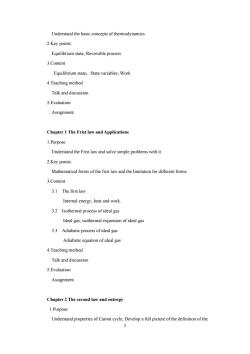
Understand the basic concepts of thermodynamics 2.Key points Equilibrium state;Reversible process 3.Content Equilibrium state:State variables,Work 4.Teaching method Talk and discussion 5.Evaluation Assignment Chapter 1 The Frist law and Applications 1.Purpose Understand the First law and solve simple problems with it 2.Key points: Mathematical forms of the first law and the limitation for different forms. 3.Content 3.1 The first law Internal energy;heat and work. 3.2 Isothermal process of ideal gas Ideal gas,isothermal expansion of ideal gas 3.3 Adiabatic process of ideal gas Adiabatic equation of ideal gas 4.Teachingmethod Talk and discussion 5.Evaluation Assignment Chapter 2 The second law and entropy 1.Purpose Understand properties of Carnot cycle:Develop a full picture of the definition of the
3 Understand the basic concepts of thermodynamics 2.Key points: Equilibrium state; Reversible process 3.Content Equilibrium state;State variables; Work 4.Teaching method Talk and discussion 5.Evaluation Assignment. Chapter 1 The Frist law and Applications 1.Purpose Understand the First law and solve simple problems with it. 2.Key points: Mathematical forms of the first law and the limitation for different forms. 3.Content 3.1 The first law Internal energy; heat and work. 3.2 Isothermal process of ideal gas Ideal gas; isothermal expansion of ideal gas 3.3 Adiabatic process of ideal gas Adiabatic equation of ideal gas 4.Teaching method Talk and discussion 5.Evaluation Assignment. Chapter 2 The second law and entropy 1.Purpose Understand properties of Carnot cycle; Develop a full picture of the definition of the
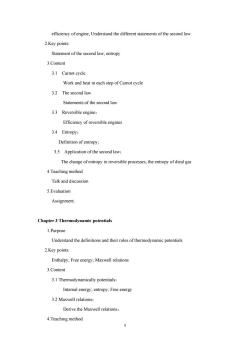
efficiency of engine:Understand the different statements of the second law. 2.Key points Statement of the second law,entropy 3.Content 3.1 Carnot cycle Work and heat in each step of Camnot cycle 3.2 The second law Statements of the second law 3.3 Reversible engine: Efficiency of reversible engines 3.4 Entropy: Definition of entropy 3.5 Application of the second law: The change of entropy in reversible processes.the entropy of dieal gas 4.Teaching method Talk and discussion 5.Evaluation Assignment. Chapter3 Thermodynamic potentials 1.Purpose Understand the definitions and their roles of thermodynamic potentials 2.Key points: Enthalpy;Free energy:Maxwell relations 3.Content 3.1 Thermodynamically potentials: Internal energy.entropy.Free energ 3.2 Maxwell relations: Derive the Maxwell relations 4.Teaching method
4 efficiency of engine; Understand the different statements of the second law. 2.Key points: Statement of the second law; entropy 3.Content 3.1 Carnot cycle Work and heat in each step of Carnot cycle 3.2 The second law Statements of the second law 3.3 Reversible engine; Efficiency of reversible engines 3.4 Entropy; Definition of entropy; 3.5 Application of the second law; The change of entropy in reversible processes; the entropy of dieal gas 4.Teaching method Talk and discussion 5.Evaluation Assignment. Chapter 3 Thermodynamic potentials 1.Purpose Understand the definitions and their roles of thermodynamic potentials 2.Key points: Enthalpy; Free energy; Maxwell relations 3.Content 3.1 Thermodynamically potentials: Internal energy; entropy; Free energy 3.2 Maxwell relations; Derive the Maxwell relations。 4.Teaching method
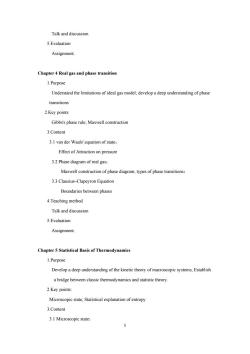
Talk and discussion 5.Evaluation Assignment. Chapter 4 Real gas and phase transition 1.Purpose Understand the limitations of ideal gas model:develop a deep understanding of phase transitions 2Key points Gibbs's phase rule;Maxwell construction 3.Content 3.1 van der Waals'equation of state: Effect of Attraction on pressure 3.2 Phase diagram of real gas: Maxwell construction of phase diagram;types of phase transitions: 3.3 Clausius-Clapeyron Equation Boundaries between phases 4.Teaching method Talk and discussion 5.Evaluation Assignment. Chapter 5 Statistical Basis of Thermodynamics 1.Purpose Develop a deep understanding of the kinetic theory of macroscopic systems.Establish a bridge between classic thermodynamics and statistic theory 2.Key points Microscopic state,Statistical explanation of entropy 3.Content 3.1 Microscopic state:
5 Talk and discussion 5.Evaluation Assignment. Chapter 4 Real gas and phase transition 1.Purpose Understand the limitations of ideal gas model; develop a deep understanding of phase transitions 2.Key points: Gibbs's phase rule; Maxwell construction 3.Content 3.1 van der Waals' equation of state: Effect of Attraction on pressure 3.2 Phase diagram of real gas; Maxwell construction of phase diagram; types of phase transitions; 3.3 Clausius–Clapeyron Equation Boundaries between phases 4.Teaching method Talk and discussion 5.Evaluation Assignment. Chapter 5 Statistical Basis of Thermodynamics 1.Purpose Develop a deep understanding of the kinetic theory of macroscopic systems; Establish a bridge between classic thermodynamics and statistic theory. 2.Key points: Microscopic state; Statistical explanation of entropy 3.Content 3.1 Microscopic state:
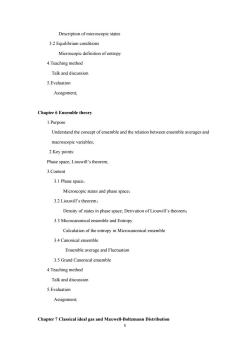
Description of microscopic states 3.2Equilibrium conditions Microscopic definition of entropy 4.Teaching method Talk and discussior 5.Evaluation Assignment: Chapter6 Ensemble theory 1.Purpose Understand the concept of ensemble and the relation between ensemble averages and macroscopic variables; 2.Key points Phase space,Liouwill's theorem, 3.Content 3.1 Phase space: Microscopic states and phase space: 3.2 Liouwill's theorem: Density of states in phase space.Derivation of Liouwill's theorem 3.3 Microcanonical ensemble and Entropy Calculation of the entropy in Microcanonical ensemble 3.4Canonical ensemble Ensemble average and Fluctuation 3.5 Grand Canonical ensemble 4.Teaching method Talk and discussion 5.Evaluation Assignment, Chapter 7 Classical ideal gas and Maxwell-Boltzmann Distribution 6
6 Description of microscopic states 3.2 Equilibrium conditions Microscopic definition of entropy 4.Teaching method Talk and discussion 5.Evaluation Assignment; Chapter 6 Ensemble theory 1.Purpose Understand the concept of ensemble and the relation between ensemble averages and macroscopic variables; 2.Key points: Phase space; Liouwill’s theorem; 3.Content 3.1 Phase space: Microscopic states and phase space; 3.2 Liouwill’s theorem; Density of states in phase space; Derivation of Liouwill’s theorem; 3.3 Microcanonical ensemble and Entropy Calculation of the entropy in Microcanonical ensemble 3.4 Canonical ensemble Ensemble average and Fluctuation 3.5 Grand Canonical ensemble 4.Teaching method Talk and discussion 5.Evaluation Assignment; Chapter 7 Classical ideal gas and Maxwell-Boltzmann Distribution
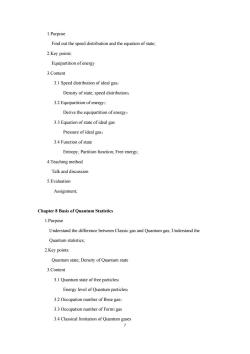
1.Purpose Find out the speed distribution and the equation of state. 2.Key points: Equipartition of energy 3.Content 3.1 Speed distribution of ideal gas: Density of state:speed distribution: 3.2 Equipartition of energy Derive the equipartition of energy 3.3 Equation of state of ideal gas Pressure of ideal gas: 3.4 Function of state Entropy,Partition function,Free energy 4.Teaching method Talk and discussion 5.Evaluation Assignment, Chapter 8 Basis of Quantum Statistics 1.Purposc Understand the difference between Classic gas and Quantum gas,Understand the Quantum statistics; 2.Key points Quantum state:Density of Quantum state 3.Content 3.1 Ouantum state of free particles: Energy level of Quantum particles 3.2 Occupation number of Bose gas: 3.3 Occupation number of Fermi gas 3.4 Classical limitation of Quantum gases
7 1.Purpose Find out the speed distribution and the equation of state; 2.Key points: Equipartition of energy 3.Content 3.1 Speed distribution of ideal gas: Density of state; speed distribution; 3.2 Equipartition of energy; Derive the equipartition of energy; 3.3 Equation of state of ideal gas Pressure of ideal gas; 3.4 Function of state Entropy; Partition function; Free energy; 4.Teaching method Talk and discussion 5.Evaluation Assignment; Chapter 8 Basis of Quantum Statistics 1.Purpose Understand the difference between Classic gas and Quantum gas; Understand the Quantum statistics; 2.Key points: Quantum state; Density of Quantum state 3.Content 3.1 Quantum state of free particles: Energy level of Quantum particles; 3.2 Occupation number of Bose gas; 3.3 Occupation number of Fermi gas 3.4 Classical limitation of Quantum gases
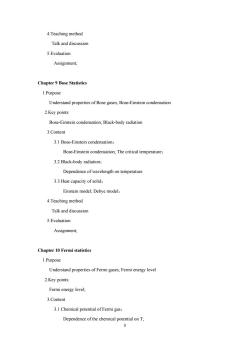
4.Teaching method Talk and discussion 5.Evaluation Assignment, Chapter9 Bose Statistics 1.Purpose Understand properties of Bose gases;Bose-Einstein condensation 2.Key points Bose-Einstein condensation,Black-body radiation 3.Content 3.1 Bose-Einstein condensation: Bose-Einstein condensation,The critical temperature 3.2 Black-body radiation: Dependence of wavelength on temperature 3.3 Heat capacity of solid: Einstein model,Debye model 4.Teaching method Talk and discussion 5.Evaluation Assignment, Chapter 10 Fermistatistics 1.Purpose Understand properties of Fermi gases,Fermi energy level 2.Key points: Fermi energy level. 3.Content 3.1 Chemical potential of Fermi gas: Dependence of the chemical potential onT;
8 4.Teaching method Talk and discussion 5.Evaluation Assignment; Chapter 9 Bose Statistics 1.Purpose Understand properties of Bose gases; Bose-Einstein condensation 2.Key points: Bose-Einstein condensation; Black-body radiation 3.Content 3.1 Bose-Einstein condensation: Bose-Einstein condensation; The critical temperature; 3.2 Black-body radiation; Dependence of wavelength on temperature 3.3 Heat capacity of solid; Einstein model; Debye model; 4.Teaching method Talk and discussion 5.Evaluation Assignment; Chapter 10 Fermi statistics 1.Purpose Understand properties of Fermi gases; Fermi energy level 2.Key points: Fermi energy level; 3.Content 3.1 Chemical potential of Fermi gas: Dependence of the chemical potential on T;
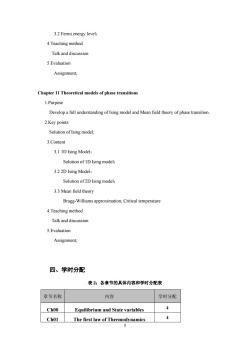
3.2 Fermi energy level: 4.Teaching method Talk and discussion 5.Evaluation Chapter 11 Theoretical models of phase transitions 1.Purpose Develop a full understanding of Ising model and Mean field theory of phase transition 2.Key points: Solution of Ising model; 3.Content 3.1 1D Ising Model Solution of ID Ising model: 3.2 2D Ising Model: Solution of 2D Ising model: 3.3 Mean field theory Bragg-Williams approximation:Critical temperature 4.Teaching method Talk and discussior 5.Evaluation Assignment, 四、学时分配 表2:各章节的具体内容和学时分配表 章节名称 内容 学时分配 Ch0o Equilibrium and State variables 4 The first law of Thermodynamics
9 3.2 Fermi energy level; 4.Teaching method Talk and discussion 5.Evaluation Assignment; Chapter 11 Theoretical models of phase transitions 1.Purpose Develop a full understanding of Ising model and Mean field theory of phase transition. 2.Key points: Solution of Ising model; 3.Content 3.1 1D Ising Model: Solution of 1D Ising model; 3.2 2D Ising Model: Solution of 2D Ising model; 3.3 Mean field theory Bragg-Williams approximation; Critical temperature 4.Teaching method Talk and discussion 5.Evaluation Assignment; 四、学时分配 表 2:各章节的具体内容和学时分配表 章节名称 内容 学时分配 Ch00 Equilibrium and State variables 4 Ch01 The first law of Thermodynamics 4

Ch02 The Second law of Thermodynamics Ch03 Thermodynamic potentials 4 Ch04 Real gas and Phase transition Ch05 Statistical Basis of Thermodynamics Ch06 Ensemble and Thermal average Ch07 Microcanonical ensemble 8 Ch08 Basis of Quantum Statistics 4 Ch09 Bose statistics 12 Ch10 Fermi statistics 4 Ch11 Theoretical models of Phase transition 4 五、教学进度 表3:教学进度表 周 章节名 内容提要 授课 作业及要求 注 Thermal equilibrium state;State variables; 1 Ch00 4 Assignment 0 The zeroth law of thermodynamics Ch01 The first law and applications 4 Assignment I Ch02 Carnot circle and The second law Assignment 2 4Cb02 Reversible Engine and Engtropy 4 Ch03 Thermodynamic potentials Assignment 3 Ch04 Real gas and Phase transition Assignment 4 Cho5 Statistical Basis of Thermodynamics 4 Assignment 5 Ch06 Ensemble and Thermal average 4 9 Ch07 Canonical Ensemble 4 ssignment 7 10 Ch07 Maxwell-Boltzmann Distribution of Classical ideal gas 4 Ch08 Basis of Quantum Statistics 4 Assignment 8 12 Ch09 Bose Statistics 4 Assignment 9 10
10 Ch02 The Second law of Thermodynamics 8 Ch03 Thermodynamic potentials 4 Ch04 Real gas and Phase transition 4 Ch05 Statistical Basis of Thermodynamics 4 Ch06 Ensemble and Thermal average 4 Ch07 Microcanonical ensemble 8 Ch08 Basis of Quantum Statistics 4 Ch09 Bose statistics 12 Ch10 Fermi statistics 4 Ch11 Theoretical models of Phase transition 4 五、教学进度 表 3:教学进度表 周 次 章节名 称 内容提要 授课 时数 作业及要求 备 注 1 Ch00 Thermal equilibrium state; State variables; The zeroth law of thermodynamics 4 Assignment 0 2 Ch01 The first law and applications 4 Assignment 1 3 Ch02 Carnot circle and The second law 4 Assignment 2 4 Ch02 Reversible Engine and Engtropy 4 5 Ch03 Thermodynamic potentials 4 Assignment 3 6 Ch04 Real gas and Phase transition 4 Assignment 4 7 Ch05 Statistical Basis of Thermodynamics 4 Assignment 5 8 Ch06 Ensemble and Thermal average 4 Assignment 6 9 Ch07 Canonical Ensemble 4 Assignment 7 10 Ch07 Maxwell-Boltzmann Distribution of Classical ideal gas 4 11 Ch08 Basis of Quantum Statistics 4 Assignment 8 12 Ch09 Bose Statistics 4 Assignment 9
按次数下载不扣除下载券;
注册用户24小时内重复下载只扣除一次;
顺序:VIP每日次数-->可用次数-->下载券;
- 苏州大学:物理科学与技术学院物理学专业《模拟电路》课程教学大纲.pdf
- 苏州大学:物理科学与技术学院物理学专业《数字电路》课程教学大纲.pdf
- 苏州大学:物理科学与技术学院物理学专业《薄膜技术与纳米材料》课程教学大纲(英文).pdf
- 苏州大学:物理科学与技术学院物理学专业《磁性物理学》课程教学大纲.pdf
- 苏州大学:物理科学与技术学院物理学专业《原子物理学》课程教学大纲.pdf
- 苏州大学:物理科学与技术学院物理学专业《量子力学》课程教学大纲.pdf
- 苏州大学:物理科学与技术学院物理学专业《力学》课程教学大纲.pdf
- 苏州大学:物理科学与技术学院物理学专业《普通物理》课程教学大纲(普通物理II——电磁与光,英文).pdf
- 苏州大学:物理科学与技术学院物理学专业《专业实验》课程教学大纲.pdf
- 苏州大学:物理科学与技术学院物理学专业《计算机辅助设计与 3D 建模》课程教学大纲.pdf
- 苏州大学:物理科学与技术学院物理学专业《薄膜技术与纳米材料》课程教学大纲.pdf
- 苏州大学:物理科学与技术学院物理学专业《磁性物理学》课程教学大纲 Magnetic Physics(英文).pdf
- 苏州大学:物理科学与技术学院物理学专业《粒子物理学》课程教学大纲 Particle physics(英文).pdf
- 苏州大学:物理科学与技术学院物理学专业《现代物理学》课程教学大纲 Modern Physics(英文).pdf
- 苏州大学:物理科学与技术学院物理学专业《固体物理》课程教学大纲.pdf
- 苏州大学:物理科学与技术学院物理学专业《光学》课程教学大纲 Optics(英文).pdf
- 苏州大学:物理科学与技术学院物理学专业《数学物理方法》课程教学大纲(英文).pdf
- 苏州大学:物理科学与技术学院物理学专业《集成电路工艺》课程教学大纲.pdf
- 苏州大学:物理科学与技术学院物理学专业《物理生物学》课程教学大纲.pdf
- 苏州大学:物理科学与技术学院本科教学手册(本科生培养方案,2022级使用).pdf
- 苏州大学:物理科学与技术学院物理学专业《电工学》课程教学大纲.pdf
- 苏州大学:物理科学与技术学院物理学专业《光学》课程教学大纲.pdf
- 苏州大学:物理科学与技术学院物理学专业《近代物理实验》课程教学大纲.pdf
- 苏州大学:物理科学与技术学院物理学专业《现代物理学在创新创业中的应用》课程教学大纲.pdf
- 苏州大学:物理科学与技术学院物理学专业《热学》课程教学大纲(英文).pdf
- 苏州大学:物理科学与技术学院物理学专业《STEAM-物理创新实验与设计》课程教学大纲.pdf
- 苏州大学:物理科学与技术学院物理学专业《电动力学》课程教学大纲.pdf
- 苏州大学:物理科学与技术学院物理学专业《普通物理》课程教学大纲(普通物理I——力学、波动).pdf
- 苏州大学:物理科学与技术学院物理学专业《电磁学》课程教学大纲.pdf
- 苏州大学:物理科学与技术学院物理学专业《普通物理实验》课程教学大纲(一).pdf
- 苏州大学:物理科学与技术学院物理学专业《普通物理实验》课程教学大纲(三).pdf
- 苏州大学:物理科学与技术学院物理学专业《普通物理实验》课程教学大纲(二).pdf
- 苏州大学:物理科学与技术学院物理学专业《热学》课程教学大纲.pdf
- 苏州大学:物理科学与技术学院物理学专业《热力学与统计物理》课程教学大纲.pdf
- 苏州大学:物理科学与技术学院物理学专业《理论力学》课程教学大纲.pdf
- 苏州大学:物理科学与技术学院物理学专业《理论力学》课程教学大纲(英文).pdf
- 苏州大学:物理科学与技术学院物理学专业《电动力学》课程教学大纲(英文).pdf
- 苏州大学:物理科学与技术学院物理学专业《半导体物理与器件》课程教学大纲.pdf
- 苏州大学:物理科学与技术学院物理学专业《固体物理》课程教学大纲(英文).pdf
- 苏州大学:物理科学与技术学院物理学专业《计算物理》课程教学大纲.pdf
